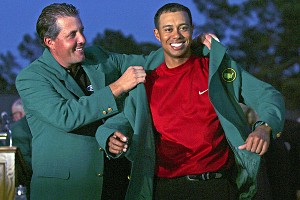AUGUSTA, Ga. -- They could replace the azaleas with cactus, the flagstick logo with mud flap girls, the green jackets with crushed pink velour, and people still would talk only about Tiger Woods during Masters week.
This is Woods' 18th Masters, which doesn't seem possible. He has more seniority at Augusta National than some of the pine trees here.
"So I've spent just about half my life playing this tournament," the 36-year-old Woods said Tuesday.
He was, is and will continue to be the centerpiece of this and every other major until he croaks. It's the natural order of things, especially with Tiger only a few weeks removed from his first PGA Tour win since 2009.
[+] Enlarge

Christopher Condon/WireImageNot since 2005 has Tiger Woods slipped on a new green jacket after winning the Masters.
Woods' blip on the Masters radar screen is larger than everyone else's. But there are other compelling storylines cleared for landing.
My favorites:
Can Rory McIlroy win the tournament a year after he shot 80 to blow a four-stroke, final-round lead? And is it true that guests now ask their Augusta National caddies to point out exactly where McIlroy nearly pull-jerked his drive into a cabin sitting room wayyyyy off the No. 10 fairway?
Can world No. 1 Luke Donald finally win a major?
Can Phil Mickelson win his fourth green jacket?
Can the highest-ranked American, Hunter Mahan (No. 4 in the world rankings), do a Kentucky and dominate?
Can defending champion Charl Schwartzel get recognized by anyone?
Can Johnson Wagner hide a pimento and cheese sandwich behind his mustache?
These are the Masters story plots. Or actually, the subplots. You-know-who still gets the star treatment.
"Obviously Tiger is always the guy that pushes the needle the most," Donald said.
And this from Lefty: "I think it's huge for him and I think he's going to have a great week because he's obviously been playing well. And to have won heading in I think gives him a lot of confidence. Sucks for us, but ..."
When he tees off at 10:35 a.m. ET Thursday, Woods will do so as a four-time Masters champion, as a resurgent player trending in the right direction and as a 4-1 favorite to win this week. But that same Woods hasn't won a major since 2008 and hasn't won here since 2005. That also doesn't seem possible, until you look at his medical chart.
Woods has been stuck at the 14 career major victories stoplight for way too long. He remains four behind Jack Nicklaus in career majors wins but only one behind the "Golden Bear" when it comes to career PGA Tour victories. A win here this week would tie him with Nicklaus' 73.
"I'd like the green jacket more," Woods said.
That's because Woods has always been about the entrees, not the appetizers. The FedEx Cup? Woods cares more about his club grips being clean. The world rankings? Yawn. His recent win at the Arnold Palmer Invitational? Fun. Reaffirming. But not a life-changer.
Woods' golf body clock starts now. Here. On that No. 1 tee box come Thursday.
His swing finally has a coat of polished wax on it. He's hitting it farther, and more often than not, the ball does what his swing tells it to do.
He's putting much better. His iron game is better. His blah, blah, blah -- shot trajectory, distance control, etc. -- is better.
"This year you can see the numbers," Woods said.
And the numbers say Woods is on the verge of being Tiger again. He's taken his game from the practice range, to the practice round, to a round in which they keep score for money. One good round has become two, then three, then four. Four good rounds became a win at Bay Hill.
Woods finished tied for fourth here the past two years. He did it despite his swing being in the repair shop. Instead, Woods depended on his vast knowledge of the place.
He told a lovely, long, winding anecdote Tuesday about playing a practice round in 1995 with Nicklaus and Arnold Palmer. Woods was an amateur back then with no walking-around money in his pocket.
"How about a little skins game today?" Palmer said before they teed off.
"Well," Tiger said, "I don't have any cash."
"Don't worry about it," Palmer said. "Just play hard."
Woods played hard, but he also questioned hard. He picked the local knowledge of Nicklaus and Palmer until their ears hurt.
"I'm trying to gain as much intel as I possibly can," Woods said. "And I'm asking them on every hole: 'What do you do here? What do you do here? What do you do here?'"
And Nicklaus and Palmer gave up every secret they knew. That's the Masters protocol.
Woods did it Tuesday. He played nine holes with Sean O'Hair, and Woods shared strategy intel on when and where to fire at a flag, where to miss on a shot. O'Hair asked for another nine-hole tutorial Wednesday.
"I think it's just the role of being here -- one as a champion and being here a number of years is that you pass knowledge on," Woods said. "It's not something that we hold and are going to keep sacred. We pass it on from one generation to the next. That's what we do."
There's another Masters tradition Woods wouldn't mind being a part of early Sunday evening. It would involve Schwartzel helping the newest champion slip on a green jacket.
Woods wants to be that guy. He wants to win the majors, not the minors. Because above all else, that's what he does.
Making sports predictions is what we do best.

